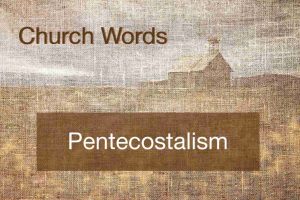 Pentecostalism is a Christian religious movement tracing its roots to an event recorded in chapter two of the Book of Acts.
Pentecostalism is a Christian religious movement tracing its roots to an event recorded in chapter two of the Book of Acts.
When the day of Pentecost came, they were all together in one place. Suddenly a sound like the blowing of a violent wind came from heaven and filled the whole house where they were sitting. They saw what seemed to be tongues of fire that separated and came to rest on each of them. All of them were filled with the Holy Spirit and began to speak in other tongues as the Spirit enabled them. (Acts 2:1-4 | NIV)
Origin of the Pentecostal Experience
Pentecost is derived from the Jewish Shavuot or Feast of Weeks, which occurred 50 days after the Passover Sabbath. It was one of three annual pilgrimage feasts that required all males to travel to Jerusalem to present their gifts to God. The Holy Spirit descended on 120 followers of Jesus, while Jerusalem was filled with visitors who satisfied that requirement. Pentecost is traditionally celebrated by Christians seven weeks after Easter Sunday.
In the minds of the early Church, what was experienced on Pentecost fulfilled an Old Testament promise. “. . . I will pour out my Spirit on all people. Your sons and daughters will prophesy, your old men will dream dreams, your young men will see visions. (Joel 2:28 | NIV)
It also satisfied the promises Jesus made to his disciples.
On one occasion, while he was eating with them, he gave them this command: “Do not leave Jerusalem, but wait for the gift my Father promised, which you have heard me speak about. For John baptized with water, but in a few days you will be baptized with the Holy Spirit.” (Acts 1:4-5 | NIV)
Before the adoption of the biblical canon, church worship services were characterized by submission to the leading of the Holy Spirit, as Jesus had promised. “When the Holy Spirit, who is truth, comes, he shall guide you into all truth, for he will not be presenting his own ideas, but will be passing on to you what he has heard. . . “ (John 16:13 | TLB) People would gather to sing, share the gospel, celebrate the Lord’s Supper and await the leading of the Holy Spirit through a member or members of the congregation.
There are many references to the working of the Holy Spirit in the New Testament Church. Still, the letters the apostle Paul wrote to the Church in Corinth demonstrate how he functioned in worship services through Spirit-filled individuals.
“The Corinthian letters, in particular, indicate that the assembled churches relied on the spontaneity of the Spirit rather than on official authority for the life and direction of their meetings.”[1] This is supported by Justin Martyr (100-165 AD): “For the prophetical gifts remain with us even to the present time.”[2] Later in the same work, he says, “Now it is possible to see among us women and men who possess gifts of the Spirit of God.”[3]
Baptism in/with the Holy Spirit
Pentecostals, in general, believe in a post-conversion experience called “baptism with (or in) the Holy Spirit” demonstrated by “speaking in tongues” or glossolalia (speech in an unknown language) or xenoglossy (speech in a language known to others but not the speaker). It emphasizes the work of the Holy Spirit in the direct, powerful experience of God in the lives of believers. Many maintain that the initial evidence of the baptism is speaking in tongues.
Those who have been filled may also receive one or more of the “Apostolic Gifts” or Gifts of the Spirit outlined in 1 Corinthians 12:7-11 (ESV):
To each is given the manifestation of the Spirit for the common good. 8 For to one is given through the Spirit the utterance of wisdom, and to another the utterance of knowledge according to the same Spirit, 9 to another faith by the same Spirit, to another gifts of healing by the one Spirit, 10 to another the working of miracles, to another prophecy, to another the ability to distinguish between spirits, to another various kinds of tongues, to another the interpretation of tongues. 11 All these are empowered by one and the same Spirit, who apportions to each one individually as he wills.
According to Hyatt, the Holy Spirit has maintained a low-key presence in some form from that first Pentecost to the present. After years of being absent from mainstream Christianity, the Pentecostal movement emerged in Topeka, KS, at Bethel Bible College.
The college’s director, a former Methodist preacher, Charles Fox Parham, instructed his students to fast, pray, and meditate on Scripture until they received the Holy Spirit baptism. On New Year’s Day, 1901, a woman named Agnes Oznam became the first of Parham’s students to speak in an unknown tongue. Others soon followed.
In 1906, the Spirit fell during a service conducted by William Seymour, a Black Holiness preacher and student of Parham. The service occurred at Apostolic Faith Gospel Mission, an abandoned African Methodist Episcopal church at 312 Azusa St, Los Angeles, CA.
As their numbers grew, many Pentecostals sought to impact their home church congregations using their spiritual gifts. However, this made some members and pastors uncomfortable, and many Spirit-filled people moved on to Pentecostal congregations. Still, opposition increased. Pastors who endorsed charismatic ideas were removed from their pulpits, and missionaries lost financial support.
Consequently, new fellowships and denominations emerged, mainly from Holiness backgrounds. However, other Holiness denominations rejected Pentecostalism, including the Methodists, Church of the Nazarene, and Salvation Army. Yet, Pentecostalism spread rapidly worldwide after 1906. That expansion was not without controversy and division. The two primary doctrinal divisions were the Trinity and sanctification.
The sanctification controversy was linked to many Pentecostals’ Holiness tradition, including Parham and Seymour. William Durham developed the “finished work” theory, which consisted of three “works: ” salvation, Spirit baptism, and sanctification. The Assemblies of God, which began in 1914, adopted his view. Most Pentecostal denominations, including the International Church of the Foursquare Gospel, are based on this model.
Oneness
By far, the most significant schism grew from the “oneness” or Jesus-only doctrine that began in 1911 in Los Angeles. Similar to Modalism, also known as Sabellianism, the doctrine is the unorthodox belief that God is one person who manifested himself in three forms or modes, in contrast to Trinitarian doctrine, where God is one being eternally existing in three persons. Oneness adherents maintain God does not exist as the Father, Son, and Holy Spirit at the same time. Instead, he is one person and has merely adopted one of the three modes as necessary at various times.
Post-World War II, Pentecostalism became increasingly acceptable to middle-class Americans. In 1943, the International Church of the Foursquare Gospel, Assemblies of God, Church of God (Cleveland, TN), and the Pentecostal Holiness Church became charter members of the National Association of Evangelicals, NAE, completely disassociating from the fundamentalists that had disfellowshipped them in 1928.[4]
Oral Roberts’s ministries in the 1950s and Demoos Shakarian’s founding of the Full Gospel Businessmen in 1952 helped mainstream the movement.
What became known as “Neo-Pentecostalism” in the 1960s in the Roman Catholic Church was led by Joseph Leon Cardinal Suenens, whom two Popes named episcopal advisor to the renewal. It exploded when an Episcopal priest, Dennis Bennett (1917-1991), detailed his Charismatic experience in Nine O’Clock in the Morning. He was forced out of his pastorate in Van Nuys, CA, but relocated to Seattle, where he pastored an inner-city parish that proliferated, becoming ground zero for the Protestant Charismatic renewal.
A.B. Simpson defined what many consider to be the four cardinal doctrines of the Pentecostal movement: salvation, baptism in the Holy Spirit, divine healing, and the second coming of Jesus. Subsequently, the belief that speaking in tongues is the initial evidence of Holy Spirit baptism was added. Finally, most Pentecostals also believe in the premillennial return of Jesus.
By 1995, the global number of Pentecostals and charismatics had reached 463 million, second only to the Roman Catholic Church. And sixty-six percent of all Christians in developing nations identify as Pentecostal or charismatic.
[1] Eddie L. Hyatt, 2000 Years of Charismatic Christianity: A 21st Century Look at Church History from a Pentecostal/Charismatic Perspective (Lake Mary, FL: Charisma House, 2002) Kindle edition, p.9.
[2] Justin Martyr, Dialogue with Trypho, vol. 1, The Ante-Nicene Christian Library, ed Rev. Alexander Roberts and James Donaldson (Edinburgh; T&T Clark, 1874) p. 240.
[3] Ibid., p. 243.
[4] V. Synan, “Pentecostalism,” Evangelical Dictionary of Theology, 2nd ed., Edited by Walter A. Elwell (Grand Rapids: Baker Academic, 2001), p. 901.
